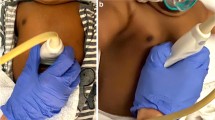Abstract
This chapter describes the surgical procedure for laparotomy for midgut volvulus as performed by the following approach: open. Indications for this procedure are classically bilious emesis in a child. An upper gastrointestinal contrast study typically confirms the diagnosis of midgut volvulus prior to operative intervention. However, in a child with bilious emesis and peritonitis, often the child is brought directly to the operating room for exploratory laparotomy due to the time-dependent nature of the diagnosis. Risks of the operation include the need for bowel resection, possible ostomy creation, and possible second-look laparotomy. There are no alternatives to surgery in the management of midgut volvulus. Essential steps include derotation of the midgut in a counter clockwise manner, lysis of Ladd’s bands of the duodenum and vascular pedicle, and appendectomy (optional).
Access provided by Autonomous University of Puebla. Download chapter PDF
Similar content being viewed by others
Keywords
Indications and Benefits
-
Bilious emesis in a child
-
Benefits: salvage of midgut small bowel
Risks and Alternatives
-
Standard risks: Bleeding, infection, need for additional procedures, and risks of anesthesia
-
Injury to adjacent structures (liver)
-
Need for bowel resection
-
Need for second-look laparotomy
-
Alternatives: None
Essential Steps
-
1.
Counterclockwise derotation of the midgut
-
2.
Assessment for bowel necrosis and bowel resection
-
3.
Lysis of Ladd’s bands of the duodenum and vascular pedicle
-
4.
Appendectomy (optional)
Template Operative Dictation (Open)
Preoperative Diagnosis
Midgut volvulus
Postoperative Diagnosis
Same as preoperative diagnosis
Findings
Same as postoperative diagnosis
Procedure(s) Performed
Laparotomy for midgut volvulus
Anesthesia
General
Specimen
None/small bowel (__ cm)
Drains
None
Implants
None
Estimated Blood Loss
___ mL
Indications
This is a/an ___-day/week/month/year-old male/female with bilious emesis and an UGI consistent with midgut volvulus. He/she was deemed to be a suitable candidate for laparotomy for midgut volvulus.
Procedure in Detail
Following satisfactory induction of anesthesia, the patient was placed supine and appropriately padded. Time-outs were performed using both preinduction and preincision safety checklists with participation of all present in the operative suite. These confirmed the correct patient, procedure, operative site, and additional critical information prior to the start of the procedure. The abdomen was then prepped and draped in the usual sterile fashion.
A transverse laparotomy incision was made approximately 1 cm superior to the umbilicus. Electrocautery was used to dissect through the soft tissue and the abdomen was entered under direct vision. The falciform was identified, doubly ligated, and transected. Care was taken not to injure the liver, and the small bowel was inspected. The small bowel was noted to be dusky in appearance, was eviscerated in its entirety through the incision, and a midgut volvulus was confirmed. The bowel was then slowly derotated in a counterclockwise manner to improve perfusion. Of note, anesthesia was instructed to observe the EKG tracings during derotation to identify EKG changes consistent with hyperkalemia. After the volvulus was fully reduced, the bowel was inspected in its entirety from the duodenum to the ileum to identify any additional abnormalities or areas of frank necrosis.
If frank bowel necrosis is identified : Surgical clips were placed/GIA staplers were fired proximal and distal to frankly necrotic bowel. The mesentery at the base of the necrotic bowel was taken using serial suture ligation/electrocautery/LigaSure vessel sealer. The bowel was passed off the field as specimen. In total, ____ cm of small bowel was resected leaving ___ remaining bowel from the duodenum to the terminal ileum. After lysis of Ladd’s bands was completed, the bowel was left in discontinuity and the abdomen was left open with a temporary abdominal closure device for a planned second-look laparotomy.
A warm, damp laparotomy pad was placed over the eviscerated bowel and attention was turned to the duodenum. Ladd’s bands between the duodenum and cecum were lysed until the duodenum was able to lie free in a longitudinal fashion along the right abdominal wall. Ladd’s bands along the pedicle of the small bowel were similarly lysed in order to open the vascular pedicle supplying the small bowel. Care was taken during dissection not to violate the mesentery of the small bowel.
The appendix was then identified and the mesoappendix was ligated. The base of the appendix was suture ligated, and the appendix transected with a 15 blade scalpel and passed off the field as specimen. The mucosal surface of the remaining appendiceal stump was cauterized.
The viscera were returned to the abdomen in the following order. The duodenum and jejunum were placed in the right upper and lower quadrants. The ileum was placed in the left lower quadrant followed by the cecum and remaining colon in the left upper quadrant. The fascial edges of the laparotomy incision were identified and reapproximated. Scarpa’s fascia was similarly closed using interrupted sutures followed by skin closure in a running subcuticular fashion followed by a surgical dressing.
Upon completion of the procedure, a debriefing checklist was completed to share information critical to the postoperative care of the patient. The patient tolerated the procedure well, was extubated in the operating room, and was transported to the postanesthesia care unit in stable condition thereafter.
Author information
Authors and Affiliations
Corresponding author
Editor information
Editors and Affiliations
Rights and permissions
Copyright information
© 2019 Springer Nature Switzerland AG
About this chapter
Cite this chapter
Kelley-Quon, L.I. (2019). Laparotomy for Midgut Volvulus. In: Papandria, D., Besner, G., Moss, R., Diefenbach, K. (eds) Operative Dictations in Pediatric Surgery. Springer, Cham. https://doi.org/10.1007/978-3-030-24212-1_18
Download citation
DOI: https://doi.org/10.1007/978-3-030-24212-1_18
Published:
Publisher Name: Springer, Cham
Print ISBN: 978-3-030-24211-4
Online ISBN: 978-3-030-24212-1
eBook Packages: MedicineMedicine (R0)




